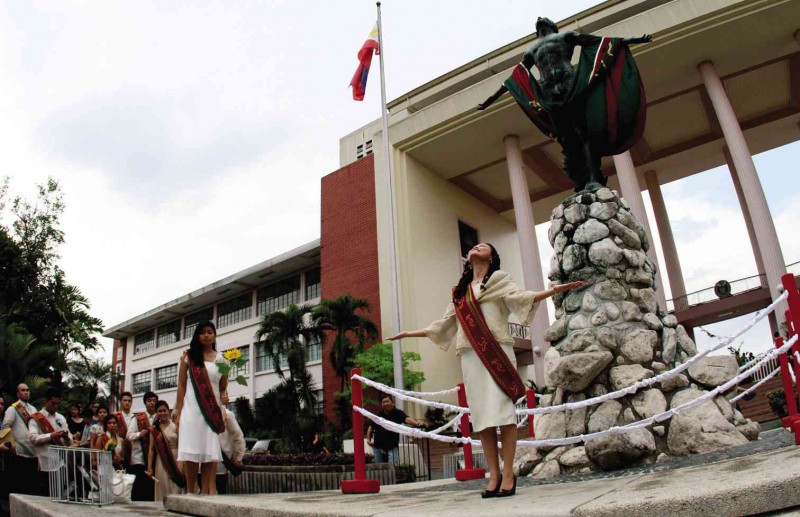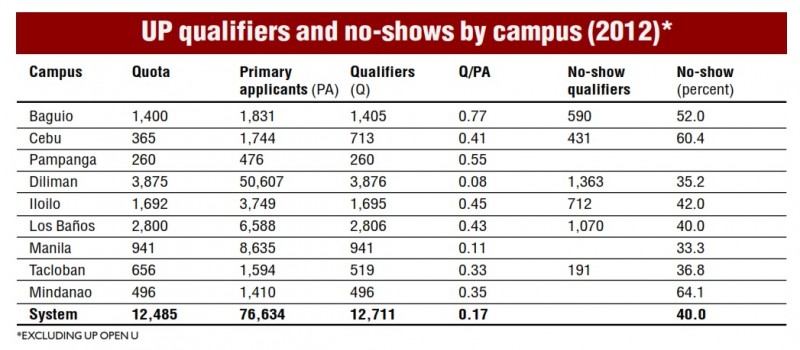Democratizing UP education

GRADUATION DAY A graduating student poses like the Oblation as others wait for their turn to have their photos taken at the statue before graduation rites in UP Diliman in Quezon City. RICHARD A. REYES
Education is an important process by which a society harnesses its vast human resources in order to build a progressive society. Because it is a social responsibility, the 2008 UP Charter has mandated the state to institutionalize—through the University of the Philippines—a mission that fulfills this.
In 2007, the university implemented the 300-percent increase in tuition, as approved by the UP Board of Regents in its December 2006 meeting. Students, faculty and staff are pointing to a situation where access of the poor sectors of our society is further sacrificed.
The death of UP Manila student Kristel Tejada was an unfortunate outcome of a trend where the poorer students are getting fewer or are being edged out. They are replaced by the richer ones. The poor-to-rich ratio is 80:20.
(Mendoza and Simbulan, April 15, 2013, Philippine Daily Inquirer).
Three interrelated drivers explain why the number of students coming from the poor sector of our society is getting smaller or why they are being “edged out” of UP. They are as follows:
UP College Admission Test (Upcat)
High tuition and other fees, particularly the Socialized Tuition and Financial Assistance Program (STFAP)
High cost of living
(See infographics on factors that edge out poor students in UP.)
High cost of living
A poor parent once said to his offspring, “If you study in UP, I cannot send sufficient allowance regularly.” Income from the farm is seasonal and irregular.
A taxi driver can hardly offset the 24-hour boundary and fuel, and take home sufficient net earnings for the daily expenses (net earning of P500/24-hour taxi rent).
UP is doing a lot to address these concerns but these do not solve fundamental problems in the admission processes and other systems that are currently in place. For one, STFAP brackets E1 (annual family income: P80,001 to P135,000) and E2 (P80,000 or less) grantees remain at less than 10 percent as discussed below.
Admission test
Upcat was started in 1968. From 2009 to 2013, around 50 percent of passers came from private schools, 20 percent from public science high schools and around 30 percent were from public general and public vocational or barangay schools.
Students from private schools have a distinct advantage over those from public schools. Upcat review must be made accessible, available and
affordable through any of the following means: Books, manuals and other review materials must be printed and be readily available at bookstores nationwide.
Upcat review materials must be made available on the UP website that is easily downloadable and/or printable. There should be a waiver of Upcat application fee for students coming from poor families.
Prospective Upcat takers from poor families in distant places should be accommodated for free in dormitories of UP exam centers the night before the examination.
Due recognition and rewards should be given to high school performance in computing the Upcat grades. Consistent with Section 9 of Republic Act No. 9500, high school salutatorians and valedictorians of public high schools should be given higher weights in the computation of the UP Admission Index (UPAI) [i.e., from 0.4 to 0.6]; from UPAI = 0.6 Upcat score + 0.4 high school weighted average (HSWA) to UPAI = 0.4 Upcat score + 0.6 HSWA.
This will give more weight to their three years of efforts rather than the four-hour Upcat exam.
Bias
In the more than four decades (1968-1969 to 2013-2014) that the Upcat has been implemented, selection has been incurring “bias” against or in favor of certain sectors of society.
One reason is a lack of information about Upcat.
“Some parents or students do not even know that there is an Upcat. At the extreme, some students and parents do not even know that UP exists!”
Affirmative actions
Many affirmative actions could be done. Example: UP should launch an information campaign about Upcat in particular, or UP in general, using local and national multimedia (radio, TV and newspaper) and the Internet; Upcat application forms should be made available on the UP website for downloading and printing by interested students.
Is Upcat the only way for freshmen to enter UP? Universities abroad are complementing entrance exams (Scholastic Aptitude Test/Acet) by interviewing the students who have passed those exams. Some colleges in UP (College of Fine Arts) are already interviewing students, which means that Upcat scores are not the sole basis of admission into UP. Other colleges may opt to do the same.
No-Upcat option
A ladderized or “no-Upcat option,” in fact, is being successfully implemented in the UP Manila School of Health Services. This can also be tried in other disciplines, like agriculture, forestry and veterinary medicine. For the Bachelor of Science in Agriculture, it can be a nondegree option. The Associate in Agriculture was tried in the 1960s.
At UP Los Baños, there is an existing Certificate in Ranger Forestry. Their graduates in this program can proceed to BS Forestry or work for a while as forest ranger or any related employment.
High tuition, other fees
Next to Ateneo de Davao University, UP Mindanao has the highest tuition in Mindanao. Mindanao State University is charging only P100 per unit. UP Baguio, on the other hand, is charging the highest tuition per unit in the north. Saint Louis University has the highest tuition fee per semester as the students enroll in 24-28 units.
Polytechnic University of the Philippines is charging only P12 per unit while Central Luzon State University is charging P130 per unit.
“Socializing” tuition through STFAP did not solve the problem. A UP Cebu mass communication student said: “The problem with UP officials is their impression that all UP incoming students are rich. The burden of proof and evidence proving otherwise rests on the student’s shoulder!”
STFAP like caste system
“STFAP talagang pinahirap para kaunti ang mabigyan (Groups E1 and E2 are few, less than 10 percent). Operationally, STFAP became antipoor despite earlier claims that it was to make UP education affordable for students admitted into UP, particularly those coming from poor families. It is in this context that STFAP’s income brackets could be compared with India’s caste system.
STFAP is difficult to be availed of by the poor students who end up not entering UP even if they pass the Upcat. (See table.) UP Cebu and UP Mindanao topped the lists of Upcat passers who did not enroll in their respective constituent universities. Hence, the colloquial no-show (referring to student applicants who took the Upcat and passed but decided not to enroll).
No-show, wait-listed
Why UP Cebu has a very low number of enrollees or high no-show rate is difficult to explain. The same is true for UP Baguio, which has a 52-percent no-show rate. UP Baguio charges the highest tuition per unit as pointed out earlier.
System-wide, the average no-show rate for the last 10 years (2004-2014) is about 40 percent. About 50 percent or more could be attributed to financial reasons.
Losing bright students
The unfilled slots due to no-show are filled up by the wait-listed students. Be they rich or poor, the data show that we are likely losing 40 percent of probably the best and the brightest students in UP.
An Upcat qualifier and a valedictorian of a high school class in Tacloban City opted to study in the University of Eastern Visayas (UEV) because her grandmother, who was sending her to school, could not afford UP Tacloban tuition rates. Furthermore, UEV gave her a scholarship plus allowances.
Students from poor families are scared trying out the process. Applying for STFAP became scary because of the following:
Too many forms to fill out (15 pages)
Costly to process (P1,000-P3,000)
Long waiting period of six months processing and same period if an appeal is made by students
Too centralized—only in UP Diliman
Only one person knows how to operationalize or compute the predicted income through the Atanacio income function, the main drawback of STFAP.
Briefly, STFAP bracketing is operationalized through the Atanacio income function. (A more detailed discussion was given by Simbulan, 2006; https://www.inquirer.net/specialreports/education/view.php?db=1&article=20061231-40945.)
The overall results of the STFAP-Atanacio income function were:
– Upward “increase” in income of poorer families and as a consequence bracket E moved up to bracket D (P135,001 to P250,000) to C (P250,001 to P500,000) [too few students in bracket E]—8 percent in UP Los Baños; about 5 percent in UP Baguio and Pampanga.
– Unrealistic and unjust STFAP bracketing, which was aggravated further by:
Non-CPI adjustments of parents’ income. In fact, they were recomputed and made higher due to the Atanacio income function.
Low-threshold income (P135,001 a year) from where the students should start paying tuition (for bracket D).
Socialized tuition systems
Here comes the Reformed STFAP called UP Socialized Tuition Systems (STS).
The STS (as approved by the Board of Regents at its meeting on Dec. 13, 2013) has the main feature of using the Mores 1SEC instrument. Mores is Marketing Opinion Research Society. The Mores 1SEC instrument is based on the ordered logistic regression model.
The Mores 1SEC instrument is based on the paper by Bersales et al. (2013)
https://www.nscb.gov.ph/ncs/12thncs/papers/IN
VITED/Panel percent20Discussion/PD-1 percent20SEC per
cent202012 percent20The per
cent20New percent20Philippine percent20Socioeconomicper
cent20Classification.pdf.
We are raising the following questions about or disagreements on the Mores 1SEC instrument and the various indicators that were used. Example: Metro Manila received the highest numeric points = 7 and Mindanao = 0 and the rest are as follows: Visayas = 1, South Luzon = 2; North/Central Luzon = 2 and Bicol = 1. Students from well-to-do families who are outside of Metro Manila are benefiting from the low point that may be added to their cluster; household head occupational status.
No jobs = 0, others = 1, managers, supervisors, government officials, corporate executives = 2.
Why do corporate executives have the same points as government officials (ordinary ones)?; House type (observation). Single detached, duplex, others = 0; apartment/townhouse/condo = 2. Why are condominiums given only 2 points and an apartment has the same 2 points? (For more details, refer to Bersales et al., 2013).
Blood, sweat
According to the UP administration, the STS, “contrary to what some sectors allege is not a scheme for revenue generation.” The amount of P1.2 billion in collected fees (tuition, laboratory plus matriculation) speaks for itself. It is “blood and sweat” extracted from the poor parents who are made to appear rich by the Mores 1SEC-guided STS.
Thailand is investing 31 percent of its education budget to tertiary education. For the 2014 proposed national budget, the Philippines is spending only about 11 percent.
Potential geniuses
The Philippine budget for education is only 2.45 percent of the gross domestic product while Unesco prescribes 6 percent. Thailand is setting aside 5.8 percent; Vietnam, 6.6 percent; and Indonesia, 3.5 percent.
Supporting more poor students, who represent the many in the “gene pool,” assures that their potential geniuses in science, arts and culture will be honed up to contribute more to development in the country.
Education dynasty
Investment in education is a sure way to inclusive growth. Diminishing it shall lead to “education dynasty” of the well-to-do families of Philippine society.
Iskolar ng Bayan is the main philosophy of UP education. RA 9500 has declared UP the country’s national university. The state should fully support UP befitting its status as a national university.
An additional P1-billion budget for UP (to cover tuition and other fees) is a sound and meritorious investment.
(This paper is based on the report submitted by the Study Group on Admissions created through Administrative Order No. PAEP 13-70 of July 22, 2013, to University of the Philippines [January 2014]. The team included Dr. Teodoro C. Mendoza, Prof. Danilo A. Arao, Dr. Ramon G. Guillermo, Dr. Fidel R. Nemenzo, Perlita C. Raña, Professor Roland G. Simbulan and Maryliz SB. Zubiri.)






















